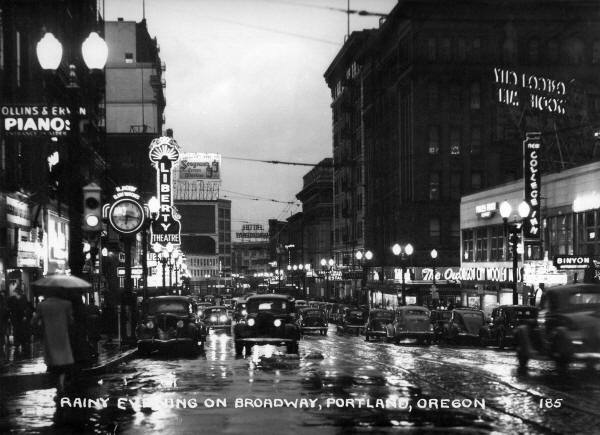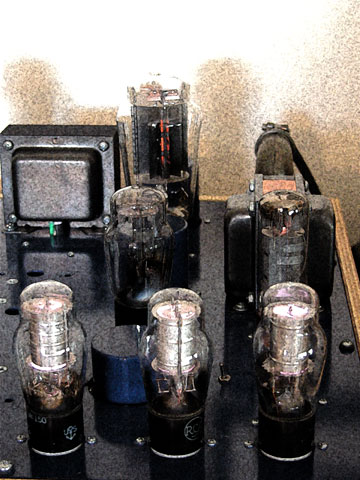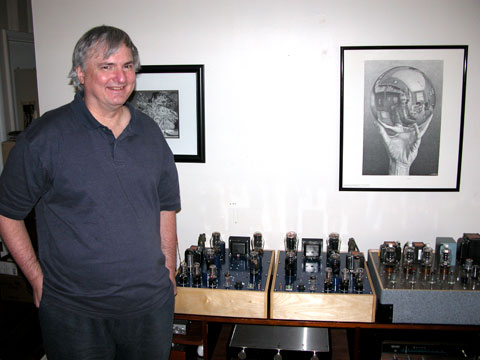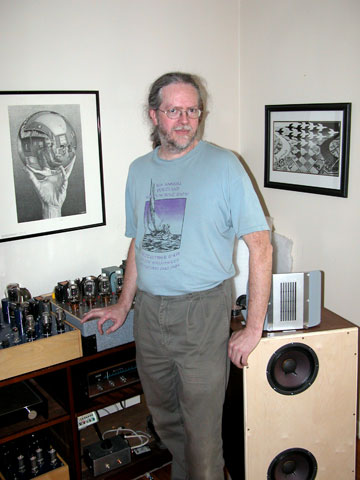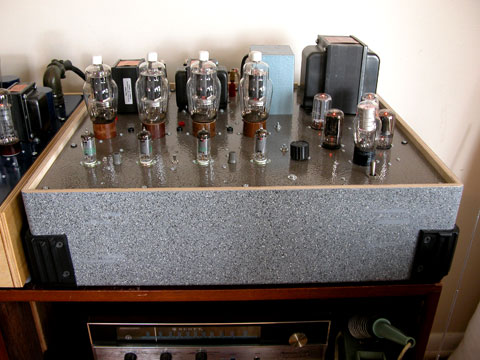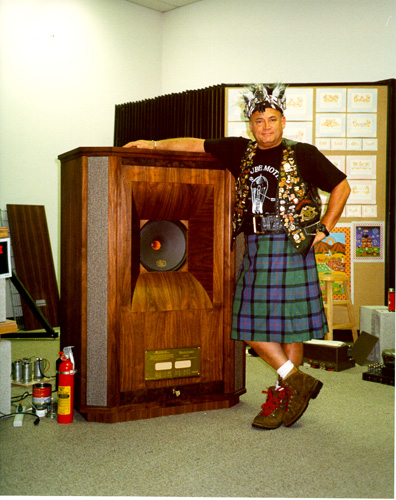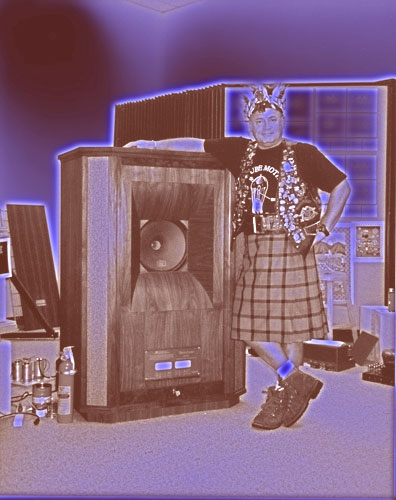|
You are reading the older HTML site
Positive Feedback
ISSUE
20
"Gizmo Lives!" With contributions by Gary Pimm and a listening footnote by "The Boss" Photographs (apart from Portland, 1936) and image processing by David W. Robinson.
I. Two men in overcoats stood at the end of the alleyway behind Powell's, the City of Books. Rain fell down brick walls, soaked through tattered political posters left over from the stolen election, and filled the gutters. On Burnside, buses filled with tired commuters rumbled by. Far overhead, in the apartments for the rich built on the ruins of the old brewery, lights blazed out in the night sky. The tall man spoke first. "Tell the Boss the shipment is leavin' tomorrow. If he wants to see the goods for himself, he better hurry, or it'll be gone. This is no joke. I mean it." The short man spoke next. "I'm not tellin' him nothin'. He only deals in legit mainstream stuff, Slim. You know that already. If it ain't passed through Vegas, Santa Fe, or Sea Cliff, da Boss ain't interested, he ain't heard about it, it don't exist, it never happened. Ya get my drift?" A cigarette flared, dimly lighting the loading dock at the end of the alley. The tall man paused, and spoke again, more sharply. "I'll keep this real simple, Shorty. The equipment was legit enough for German customs, OK? It took the Professor to explain to the X-Ray techs what they were even looking at. Get the picture? This is from another planet compared to those other places. One time only, Shorty. I don't think the Boss will like it if he hears what he missed thanks to you. Think it over—but I ain't got all night." The alleyway remained in shadows as the people overhead partied in their apartments. Dance music boomed into the rainy night, a glass broke, a man shouted, and a woman laughed hysterically. The two men looked at each other. "OK, Slim, you got me. Where is it, and when?" "Turn right at the Quonset hut. You'll see a note on the door. That's the place. Tomorrow before it gets dark. If you're late, it'll be gone." Silence, then a glint of glass between the rain-soaked overcoats. Smooth-plate Telefunkens, made in Cold War Germany, with a vacuum harder than the surface of the Moon. The crinkle of fresh Swiss Francs, silver-gold metallic thread woven in the notes. The men turned away from each other, but before walking away, the tall man murmured under his breath: "Gizmo Lives!" II. The rainswept residential street was deserted. A handwritten note was pinned to the door of the small house, partially hidden by the storm door. "C'mon, Shorty, I ain't got all day. Knock already." Bam! Bamma—Bam! Bam!—the door yanked open, and the man inside said: "Two Bits!" Muttering "wise guy" under their breath, the two men stepped into the house, stopping suddenly as they saw the equipment filling the far wall. The owner of the house discreetly shut the door.
"Jeez Louise! Willya lookit that! It's like Tokyo at night!" The Boss spoke: "Enough editorials, Shorty. Set up my camera and tripod. We'll need documentation of this." Some time later, with the cameras filled with photos, the other man could contain himself no longer. "Why all da picshas, boss? Ain't we writin' an article ‘bout all dis? Why all da picshas?" "It's real simple, Shorty. A lot of the readers don't read too good, and the ones that do, they don't think too good. So we show them all the pretty lights and pretty colors, they go, "Oooh! Ahhhh!" and want to see more. So we take lots of pictures, the Photoshop geek makes them all sparkly and artsy, and lots of people look. That's how we keep the Wheels of Industry turning, see?"
The Professor walked in, carrying a slate pad. "Speaking of turning, Boss, we need to do a little temporal stabilizing before we go any further. That flicker we're seeing isn't just our imagination." The Professor opened the pearl-finish tablet to its full size, and tapped the dim pulsing apple logo at the upper right corner. A hologram sprang into life two feet above the pad's surface. All conversation stopped. "We're getting a lot of temporal multipath right now—that's why the lights seem to be flickering, and the air seems to wetter, heavier, and denser than usual. If it's doing this to us, you can only imagine the results it'll have on the readers. Time for a little fine-tuning." The display floated in air, with steady green graticule marks labeled "1925", "1935", "1945", and so on, ending at "2025". The professor touched the wavering line above "1935" and numbers flickering between 85% and 100% appeared in orange above it. "That's the probability of that timeline affecting us right now. The two sidebands to the left and right of that ridge are some of the temporal multipath—"time echoes" to you—that are affecting us. By adjusting the phase of the sidebands on the Temporal Spectrum Analyzer, we can move around ever so slightly in 11-dimensional quantum space, and reduce the time jitter in the local area—an area about the size of this room." The professor reached into the display and very slowly moved a virtual dial copied from a 1932 Weston multimeter. The temporal sidebands gradually dropped into the noise, and the Probability display rose to "100%". The lights in the room grew brighter, and the subtle mental fog lifted. The air seemed clearer, sharper, with all the edges on everything just a little crisper. Shorty couldn't resist: "What about all that noise at 2025, Prof? Why is it jumping around and changing colors between red, blue, and green like that?" The Professor sighed. "That's the probable civil war between the Christian Dominion and the Tom Painers. Congress passed the "Ownership Society Act" re-legalizing slavery in 2024, the East and West Coasts seceded, and full-scale civil war broke out—or will break out, or could break out—in 2025." The Professor touched the wavering, unstable line hovering above "2025", and Probability display jumped around between 15% and 40%. "You see, it changes not only day by day, but with every action that people are taking right now. A secret oil deal signed in Saudi Arabia; a worldwide satellite network bought and sold by an Australian billionaire; and a programmer quietly writing lines of code at an elections-machine company. All of it affects the time-space probability dispersion, and intensity of the events around 2025. Hmm—this is where most of our temporal noise is coming from, actually." The Professor reached inside and carefully moved several virtual knobs. The background sounds of the city came to a peak—shouts, talk-radios turned up to a scream, ambulance sirens, and a sort of background hiss to everything—and then suddenly faded into calm, once again the sound of a quiet street in the Northwest. The display at "2025" faded into background noise, and the orange "Probability" display dropped to zero and faded to green. The "2085" display became more solid and went to deep, steady green. "Oh, that's Cascadia. That's when I got this little unit—desktop fusion powered, so no issues with phase noise from the local power grid. Battacharya zero-point temporal stabilization is what made it all possible. Look at this display—this is the 2-D spectrum, here's the 3-D time spectra." The display went from a transparent multicolor blackboard to what looked like the Rockies as seen from space, with topographic lines flickering like lightning over the immense virtual expanse of the timescape. "And this is the 4-D display ..." The room went pitch-dark, then dazzlingly white, red-green afterimages burned, windows opened in gray expanses at odd angles, and for moment the room seemed to turn inside-out before shattering into a million shimmering points of light. There was a click, and the room was dark again. The Professor apologized: "I'm sorry, I got a little carried away there. I forgot you couldn't see in four dimensions yet. Sorry, guys. Just rest your gaze at one place for a minute to stop things from spinning around." Everyone else held on tight to the nearest piece of furniture. There was a stunned silence. It isn't everyday you experience 1935, 1955, 2005, 2085, and four dimensions all at the same time. Nobody knew what to say—the ground underneath their feet had moved, and nothing was quite solid anymore. "C'mon, let's all sit down for a little while. I know that was a bit of shock, but we had to get all that clutter out of the way before we started the interviews. Can't have all those ghosts from the Thirties and Fifties hovering around, can we?" The Boss clipped a lapel mike to Lynn's lab coat, warmed up the Stellavox recorder, and set the recording levels. The Boss started the tape by introducing Lynn Olson, and asked the first question. III. Something very close to the Karna could have been built in 1936—there wouldn't be the current sources for the input and driver section, but RC or LC isolation. That wouldn't change the basic character of the Karna, which is a 3-stage amplifier with a signal path consisting of transformers, wires, and triodes, and nothing else. No resistors, no capacitors, and no cathode followers, cascodes, phase splitters, SRPP's, or other latter-day innovations.
Audio Gizmologist (12th Degree, 11th dimension) Lynn Olson and the ay caramba! Karna monoblocks The Amity (which preceded the Karna) was built as a thought experiment: I wanted to hear what a real, textbook-style PP amplifier actually sounded like. When you read Norm Crowhurst carefully, he alludes to the fact that transformer phase splitting is the theoretical ideal, and various forms of vacuum-tube phase splitters are approximations. I found out that high-level phase splitting (between the driver and output tube) asks not only a great deal from the interstage transformer, it also asks the near-impossible from the driver tube as well, especially if the output tubes are extremely linear direct-heated triodes. Although DHT's are several times more linear than pentodes, they also require 2 to 3 times as much drive voltage, and are nasty capacitive loads as well, presenting 60 to 100pF at each grid. This imposes severe requirements on the driver stage; if it falls short, you'll never hear the clarity and directness of the DHT, just the distortion from the driver. It's not considered good engineering practice to have an earlier stage have more distortion than the output; traditional engineering favors the most distortion at the output, substantially less at the driver, less at the input, etc. etc. as you move towards the source. Since voltage and current levels drop as we work our way back towards the input, this only makes sense. The output has to work the hardest (driving the speaker), so naturally it has the most distortion. Extremely linear DHT's raise the bar everywhere else in the circuit; if you really want to hear just how good they are, distortion everywhere else must fall correspondingly, otherwise you'll just be hearing more of the same kind of distortion as every other amp out there. Not surprisingly, the most linear driver stage ended up looking just like the output stage; transformer-coupled PP in full-time class A operation. For the best performance, the phase-splitting is done at the lowest possible level, the input of the amplifier. Phase-splitting at a higher level (typical in most conventional PP-pentode amplifiers) risks substantially greater distortion at the 20X greater signal levels that follows the first tube in the amplifier.
Lynn Olson's very tasty Karna monoblocks; the power supply is two shelves below, at the very bottom of the photograph There's also a subtle benefit of PP interstage coupling I wanted to explore; nothing that was mentioned in the literature, it was a sort of theoretical benefit, but worth exploring. Conventional PP amplifiers are really a pair of SE amplifiers that are current-mirrored (summed) at the output transformer; in other words, each driver tube drives its own output tube, with no coupling between the two sides until the pair of signals meet at the primary of the output transformer. This has a subtle disadvantage: the intrinsic reduction of even-harmonic distortion that PP offers is not available to the power-tube grids, which see the full distortion spectrum of the driver (and input) stage. In theory, this is all cleaned out by the final summation in the output transformer, but multiplication of harmonics in successive gain stages may wipe out much of this advantage. Transformer coupling has the interesting advantage that each stage is its own little amplifier, complete with its own independent grounding, and in this case, its own PP cancellation of even-harmonic distortion terms. This means the grid of each 300B is presented with a low-distortion signal coming from a complete fully-balanced amplifier ahead of it, not just the output from a single RC-coupled tube. In terms of distortion, that's not a small difference; it can mean a tenfold reduction of distortion from the driver stage, as well as much more current available for Class A2 operation. (When one 300B grid goes into conduction, the full power of the preceding PP amplifier is available to it. It also means much more linear current is available to drive the high capacitance of the paired 300B grids.) This is different than just about any other PP amplifier on the market, which are almost all Williamson derivatives of one sort or another. For reasons that are not clear, the introduction of the Williamson in 1948 erased all other amplifier topologies; it took until 1956 for even minor variations to appear (the Dynaco, Acro, Marantz, etc.), and these variations continue to dominate the vacuum-tube PP-amplifier market of the present day. I loved the sound of the Ongaku and Reichert (as readers of this magazine know), but I never bought into the whole SE-DHT lifestyle thing. I was pretty sure it was the tubes themselves—direct-heated-triodes—that got the credit, not the much-ballyhooed "simplicity" of the SE circuit. This is what started the research into pre-Williamson circuitry. You can see several articles about this at: http://www.nutshellhifi.com/library/Rosetta_Stone.html http://www.nutshellhifi.com/library/tinyhistory1.html http://www.nutshellhifi.com/library/tinyamps.html http://www.nutshellhifi.com/library/FindingCG.html The biggest reservation most engineers have about transformers—all of them, from input to interstage to outputs—is the not-so-great measured performance, especially compared to capacitors. Caps, even very mediocre-sounding Mylar caps, measure really well, practically DC-to-light, and distortion measures at extremely low levels, down in the -120dB or better range. The arcane differences that appear in the DA and DF measurements barely affect bandwidth and distortion at all, although they certainly separate the bad (tantalums, discs, electrolytics, Mylar) from the good (Teflon, other exotics). Although modern transformers from Lundahl, Jensen, S&B, Tribute, and others are far better than the collectible 1930's models—with much lower distortion and bandwidths from 10Hz to 100kHz—that's still not impressive compared to any capacitor. But, but—and here we enter the wooly world of subjective impressions—there's something wrong with capacitors that measurements aren't showing. If the bandwidth and distortion measurements for caps meant anything at all, even the funkiest electrolytic would sound fantastic—or would be sonically transparent, at least. But this isn't the case. There's something sonically wrong with caps that measurements aren't indicating. By the late 1970's, all high-end speaker designers knew enough to start avoiding electrolytic caps in their crossovers. A few years later, Mylars fell into disfavor when people started measuring DA and DF and switched to polypropylenes.
We've now progressed to exotic metal-foil polypropylenes, paper/oil/wax, and most expensive of all, metal-foil Teflons. And you know what? They all sound different—not just a little different, but completely-different-amp different. A single ill-chosen cap can dominate an entire system, wiping out the difference between SE and PP, tube or transistor. That's how different they sound. Frankly, the reasons for the strong sonic coloration of coupling capacitors are not well understood, just as the difference between silver and copper cable are not well understood. But they are real enough in any system beyond home-theater grade. Oddly enough, once you start experimenting with transformer coupling, the differences are much smaller. Yes, there are bad transformers out there—vintage being some of the worst. But modern transformers from recording-studio-quality vendors are really good, and sonically not that far apart. I find them pretty close to the famed "straight wire"—and A/B bypass tests are fast and easy to perform, just to keep things honest. Gary Pimm does them all the time. Transformers also solve some difficult electronic problems: they break the ground connection between components, stopping ground loops. They filter off RFI noise from digital sources, preventing slewing distortion in analog electronics. And—in the amplifiers I've been working on—they make very good passive phase splitters, with very accurate phase splitting, and very low distortion (compared to vacuum-tube phase splitters). I'd be the first to admit that to most audio engineers, transformer-coupled circuits are repugnant. Direct coupling looks so much nicer and measures ever so much better. Just get out the Op-Amp Applications Handbook, grab a box of chips, and slam-bam-thank-you-m'am, there you are. Problems all solved. Except it doesn't sound very good, particularly compared to those recordings made in the 1950's where there were probably ten or more transformers in series between the microphone and the master tape. This is what first led to the Amity—a two-stage all-transformer-coupled PP amplifier—and the Karna, a three-stage all-transformer-coupled PP amplifier, both architectures that haven't been seen since the mid-Thirties. The Amity and Karna are described in more depth at: http://www.nutshellhifi.com/triode1.html I wasn't interested in the retro angle at all; I just wanted to hear what a classic, 1930's-textbook PP amplifier actually sounded like. Well, they're a lot different, and not retro-sounding at all. I grew up in the Fifties, and modern amps that intentionally sound "retro" just sound like an old Seeburg jukebox, or at worst, a Sears Silvertone table radio. No thanks, I didn't like that sound then, and I don't like it now.
I'm interested in exploring the sound of direct-heated triodes in simple, linear, and intrinsically low distortion circuits, but without the latter-day diversions of split-load inverters, cathodynes, SRPP's, mu-followers, active loads, or other complexities. These gadgets are intellectually interesting, and look great on paper, but can be a real challenge to debug and chase out the assorted colorations they add to the circuit. Both Gary Pimm's and my amplifiers could have been built fifty or seventy years before they were—but weren't. The only things we have now that are better—far better, really—are higher quality sources, speakers, transformers, and measurement techniques. "OK, that's it, Lynn—that's enough for today." The tape was nearing the end of the reel. The Boss unclipped the mike, fast-forwarded to the end, the reel emptied out and spun a few times, and the Boss turned the tape over and re-threaded the Stellavox. "Your turn, Gary—wait a moment while Shorty does your microphone. OK, start with the tech stuff, maybe one or two of the readers might even understand, you can never tell with people who read hi-fi magazines." IV.
Portland's Gary Pimm, audio Gizmologist and undercover secret agent (he won't tell his degree and dimensional count… if he does he'll have to kill us!) extraordinaire The simplest description of the Tabor is a "differential current amplifier driving a differential current to voltage amplifier using local feedback." The Tabor amplifier is an experiment to see what kind of sound quality can be achieved using pentodes. By the time pentodes were in common use in power amplifiers the power race was on. It was more important to try and get the absolute maximum power out of a pair of tubes and sound purity was relegated to the back seat. Almost all pentode amplifiers have been designed for high power, using a combination of class AB biasing and lots of global feedback to keep the distortion numbers down. In contrast, the Tabor was designed for maximum signal fidelity and the power output took second place. The search for sound quality lead the design in a completely different direction than current production amplifiers and almost anything built since the late 30's. The amplifier is a fully differential, class A, DC coupled amplifier that has no coupling capacitors in any of the signal current loops. None! The high performance constant current sources (CCS's) used to bias each stage allow the designer to carefully define the signal current loops and keep the AC signal currents out of the power supply and it's attendant capacitors. Before we get further into the technical details of the Tabor here is a small bit of information discussing the differences between triodes and pentodes: Triodes are fairly close to voltage amplifiers, have moderate output impedances, and operate most linearly when they are unloaded (distortion rises with decreasing load impedance). By contrast, cascoded triodes, pentodes, and MOSFETs are current-mode devices, have high output impedances, and operate most linearly into well-defined resistive loads that are a small fraction of that impedance. OK, back to describing the Tabor.
Gary Pimm's Tabor all-Pentode amplifier The first stage is a balanced, or differential, current amplifier. The input stage functions to convert the input voltage to a balanced output current. Like all current amplifiers, the output impedance is high. The second stage of the Tabor is another differential amplifier—with a key difference; the local feedback resistors configure the amplifier stage as an inverting current to voltage amplifier. The input current working into the feedback resistors characterizes the voltage gain of the output stage. Mathematically, the equation would be written as E=I*R where E is voltage, I is current and R is resistance. This is one of the variations of Ohm's law, one of the most basic fundamental building blocks of electronics. In the Tabor amplifier, the output stage gain is 136 volts per milliamp. One of the interesting things about local feedback amplifiers is the local feedback works best if it is driven from a high impedance source. If the output impedance of the input stage is high enough, the output impedance of the output stage is equivalent to a cathode follower stage. Unlike a cathode follower stage, the local feedback stage has gain. I'd like to thank John Broskie of Tube Cad Journal for the work he has done on the mathematics behind the operation of local feedback. For more in-depth mathematical information on local feedback and many other tube design features go to the Tube Cad Journal homepage at: http://www.tubecad.com. (The local feedback article is in the Issue Archive, March 2001 issue.) What isn't obvious from looking at the schematic is the local-feedback resistors actually form the load that the first stage works into, and the ratio between the cathode impedance of the first stage and the local-feedback resistors actually sets the gain of the overall amplifier. The effectiveness of the local feedback is demonstrated by the very high rejection of microphonics and filament noise—much higher rejection than conventional global-feedback amplifiers. The simplest reason for this much-improved rejection is feedback is applied directly to the noise-generating tube, instead of the amplifier as a whole, thus avoiding commingling of the noise-correcting term to the overall signal path. One of the most important problems of designing any amplifier—tube or transistor—is driving the output stage. The problems for the driver stage are frequently so severe it dominates the sound of the entire amplifier; for example, a common problem in many amplifiers is the driver can't deliver a low-distortion, large-excursion signal into the capacitance of the output stage. This results in a compressed, congested, and opaque sound at high levels. To really overcome this problem, a driver stage needs to be over-designed compared to what the textbook requirements spell out.
The Karna and Tabor approach the problem of driving the output stage in completely different ways; the Karna overcomes the substantial Miller capacitance of the 300B output triodes by the sheer power of the 45 driver stage, which is a small power amplifier in its own right. The Tabor sidesteps the problem entirely, by using output pentodes with 50 times less capacitance at the grid terminal than a power triode, and a very straightforward pentode front end. Although the Tabor could have been made in the Thirties, it's pretty different than the way they thought about amplifiers back then—in fact, it's completely different than PP pentode amplifiers on the market now, which don't use local feedback at all.
To read more about the Tabor, and the 47 direct-heated-pentode PP amplifier that preceded it, visit http://home.pacifier.com/~gpimm. Be sure to check out the "CCS's and signal current control" in the presentations section for more thoughts on what the "signal path" really includes. Lynn's webpage takes another look at "signal path" and what it really includes. Look in the Soul of Sound Library for the ETF presentation at http://www.nutshellhifi.com/library/ETF.html. Gary disconnected the microphone; the tape on the Stellavox was rewound, taken off the spool, and boxed. The Boss put the tape box inside his briefcase. "OK guys, I think that wraps it up. Professor, I think we'd all be glad if you put away your little box now." V. A storm was approaching and little gusts of wind stirred the dry leaves on the quiet residential street. A short man in a kilt turned the corner, walked down the darkening street, and reached for the Leica M3 in the camera bag. He snapped on the flashgun, opened the flash reflector, inserted a #5 flashbulb, and set the aperture of the 135mm Hektor to f/8. He positioned himself at an oblique angle to the window of the house across the street, focused the rangefinder, and pressed the shutter. He moved, and took another picture, from a different angle. Another. The Leica was silent, and the flashes could be mistaken for distant lightning. Next week, 8 x 10 glossies were mailed to the 15th-floor editorial office of the Positive Feedback Building in downtown Portland, sent by pneumatic tube to the press room on the 4th floor where the rotogravure screens were made, and printed as a special insert into the issue you are reading now.
The Gizmo, just before leaving on assignment… Aside from the photos, which bear a tiny "Gizmo" in lower right corner, the only evidence left behind by the man in the kilt were spent #5 flashbulbs lying in the curb—and the flashes of light, seen only by the cats in the window. Lynn Olson Visit: http://www.nutshellhifi.com A listening footnote from "The Boss" I was driving to a secret place in River City, tipped off that I was missing some amazing developments in the tubulous realm of fine audio. If I really wanted to see something new, I'd have to meet clandestinely with the audio agents of change, PDX branch. Nothing ventured being nothing gained, I shoveled some time free in my schedule (no bloody little task these days), grabbed my Nikon digital, and hit the road. Yeah, I have to say it: it's glad I am that I did so. I've known Lynn Olson from the very early days of the Oregon Triode Society, back in the days when he was between sand and glass. Close encounters every now and then, over here in Positive Feedbackville… Lynn on a long audio hejira that went from solid states to glowing orbs. He's come a very long way since his first encounter with the Audio Note Ongaku-based system. That shifted him onto a completely different path. I had heard some of Lynn's excellent speaker design work years back, but hadn't heard his new work in electronics. Gary I hadn't even heard of, much less heard his designs. I only spent an afternoon session listening to the Karna and the Tabor. Not long—but long enough to know that I was hearing something special. Each of these designs was making some very serious magic with its own vector on real music. We listened to LPs only; this is because only LPs, SACDs, and open reel tapes really have any prospect of being able to breathe. The Karna had the choice goodness that belongs to 300Bs, but it was missing the usual weaknesses of most 300Bs I've heard. The sound wasn't emphasizing the midrange at the expense of the bass or the higher frequencies. There was a real sense of air and a good bass foundation that I wasn't used to hearing from 300B-based designs. No doubt about it: the Karna busts the 300B stereotype, but good! The only other 300B that I've heard that's anything like this is the Wavac MD-300B, and that's a bloody huge compliment to Maestro Olson, believe me. Unlike the 300B's of the Karna, Gary Pimm's Tabor was not like anything I was familiar with. Pentode amplification was something I associated with "power at any price," the price always being the quality of the sound. Volume, yes. Beautiful subtlety, no. But Gary's Tabor was a revelation. It had power, but it also demonstrated nuance and musical detail of a kind that I wasn't used to hearing from pentodes. Clean and clear, yes… but always a delight to listen to. And that put it into some pretty special company in my experience: Wavac, Wavestream, Joule-Electra, Audio Note, the best of the Manley Labs, maybe a few others that I'm forgetting right now …but the list is pretty short. There wasn't enough time for me to listen extensively and develop detailed listening notes. But take my word for it, the Karna and the Tabor amplifiers represent really important new work in glowing glass design. The way that both amps made me feel—relaxed, and enjoying the ease of a system and room that I was completely unfamiliar with—is a very important sign that something's very right with these designs. Glass lovers, take note: you'll want to get in touch with Lynn and Gary to learn more about what they're doing. There's some major magic happening in the Karna and the Tabor!
Gizmo caught in mid-warp to future days….
|

